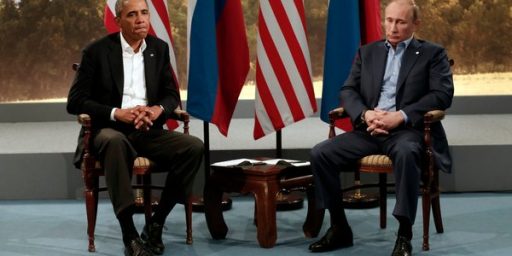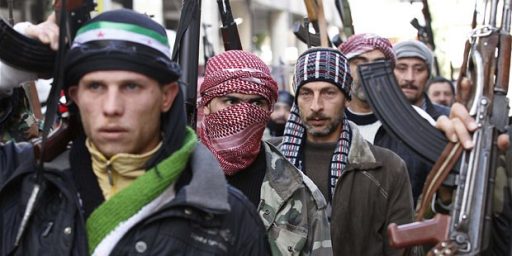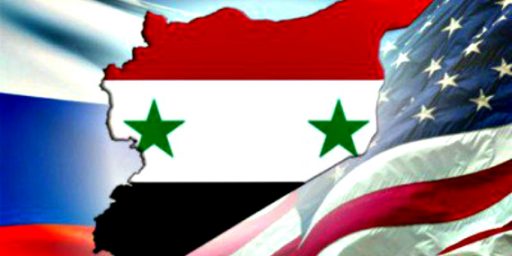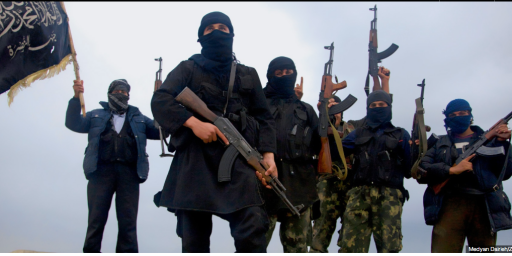‘Khorasan Group’ is US Creation; It’s Still Dangerous
The Khorasan Group is, functionally, al Qaeda. Or is it?
NRO’s Andrew McCarthy makes a provocative statement: “The Khorosan Group Does Not Exist .”
You haven’t heard of the Khorosan Group because there isn’t one. It is a name the administration came up with, calculating that Khorosan — the -Iranian-Afghan border region — had sufficient connection to jihadist lore that no one would call the president on it.
The “Khorosan Group” is al-Qaeda. It is simply a faction within the global terror network’s Syrian franchise, “Jabhat al-Nusra.” Its leader, Mushin al-Fadhli (believed to have been killed in this week’s U.S.-led air strikes), was an intimate of Ayman al-Zawahiri, the emir of al-Qaeda who dispatched him to the jihad in Syria. Except that if you listen to administration officials long enough, you come away thinking that Zawahiri is not really al-Qaeda, either. Instead, he’s something the administration is at pains to call “core al-Qaeda.”
“Core al-Qaeda,” you are to understand, is different from “Jabhat al-Nusra,” which in turn is distinct from “al-Qaeda in Iraq” (formerly “al-Qaeda in Mesopotamia,” now the “Islamic State” al-Qaeda spin-off that is, itself, formerly “al-Qaeda in Iraq and al-Sham” or “al-Qaeda in Iraq and the Levant”). That al-Qaeda, don’t you know, is a different outfit from al-Qaeda in the Arabian Peninsula . . . which, of course, should never be mistaken for “al-Qaeda in the Islamic Maghreb,” “Boko Haram,” “Ansar al-Sharia,” or the latest entry, “al-Qaeda in the Indian Subcontinent.”
Coming soon, “al-Qaeda on Hollywood and Vine.” In fact, it wouldn’t surprise me if, come 2015, Obama issued an executive order decreeing twelve new jihad jayvees stretching from al-Qaeda in January through al-Qaeda in December.
Except you’ll hear only about the jayvees, not the jihad. You see, there is a purpose behind this dizzying proliferation of names assigned to what, in reality, is a global network with multiple tentacles and occasional internecine rivalries.
As these columns have long contended, Obama has not quelled our enemies; he has miniaturized them. The jihad and the sharia supremacism that fuels it form the glue that unites the parts into a whole — a worldwide, ideologically connected movement rooted in Islamic scripture that can project power on the scale of a nation-state and that seeks to conquer the West. The president does not want us to see the threat this way.
McCarthy doesn’t do much to bolster his credibility by sandwiching that analysis between rants about President Obama’s “alternative national-security reality” and assertions like, “For a product of the radical Left like Obama, terrorism is a regrettable but understandable consequence of American arrogance.” There are several other issues with the piece (more on which later) as well.
The titular claim about the Khorosan (usually spelled Khorasan) Group is correct, however. WaPo’s Adam Taylor was two days ahead of McCarthy on “The strange story behind the ‘Khorasan’ group’s name“:
In part due to its place in Islamic history, the term Khorasan is used by modern Jihadist groups, especially those based outside Arab states. The online magazine of al-Qaeda in Afghanistan is called “Vanguards of Khorasan,” for example, and J.M. Berger, an independent terror analyst, says that al-Qaeda has often signed its communiques as emanating from Khorasan over the years.
“Jihadists deny the legitimacy of most modern nation states; they prefer using historical terms, typically the ones that were used during the time of the great Caliphates (which is obviously what they want to go back to),” Peter Neumann, director of the International Centre for the Study of Radicalization, explained in an e-mail.
In particular, the hadith mention gives the reference added power. ”The symbology of this has been important for jihadis since the so-called black banners being raised in Afghanistan, which is part of Khorasan, in the ’80s against the Soviets until now,” Aaron Zelin of the Washington Institute for Near East Policy said, adding that Islamic apocalyptic literature has become a central theme for some jihadist groups fighting in the Middle East.
While there have been reports of groups in Pakistan taking on the Khorasan label, analysts cast doubt that the term is being widely used within Syria to refer to any distinct group. ”There have been no jihadis in Syria or [Jabhat al-Nusra] to use that name when referring to themselves,” Zelin said. ”Some online jihadis have even characterized it as laughable.”
Pieter van Ostaeyen, a historian and blogger who follows jihadist movements, writes in an e-mail that “in all of the official Jihadi accounts I follow(ed), the name never was mentioned.”
Even after the use of the phrase by U.S. officials, the Khorosan label still seemed obscure to many in Syria. The Post’s Loveday Morris said that most Islamist fighters she spoke to had never heard of any Khorasan group, and those that used the word used it to refer, more broadly, to fighters from Afghanistan and Pakistan rather than a specific group.
There seems little doubt that experienced al Qaeda operatives from the “Khorasan” region are now operating with the group’s official proxy in Syria, Jabhat al-Nusra. Fadhli, who is believed to have been killed by U.S. strikes this weeks, was a Kuwaiti national who had been based in Iran. He is believed to have been sent to Syria by al-Qaeda’s core leadership to help it in a fight in which it had been sidelined.
What’s disputed is whether the Khorasan group is really any different from Jabhat al-Nusra, or whether it can even constitute a distinct entity at all. U.S. intelligence is reported to not see it so much as a rival group to Jabhat al-Nusra but as a group of foreign fighters “nested” with Jabhat al-Nusra and other groups.
Analysts agree this seems most likely. “The [Khorasan group] is al-Qaeda, and there are no indications that they have split from al-Qaeda,” Neumann explains. “Jabhat al-Nusra is al-Qaeda’s official affiliate in Syria, and this means — de facto — that they would be part of Nusra.”
The administration’s motivation for using a made-up name for a subfaction of the al Qaeda threat is not clear. But McCarthy’s explanation, that the intent is to hide the fact that al Qaeda has not, as the president has repeatedly claimed, been “decimated” is unlikely to be the reason. More likely is that they needed a way to distinguish two parts of Jabhat al-Nusra that are actually very different from the standpoint of US foreign policy. The Hill’s Kristina Wong:
The Khorasan Group consists of veteran jihadists from Afghanistan and Pakistan with long combat experience and its leader was once part of Osama bin Laden’s inner circle.
The group was personally dispatched to Syria by al Qaeda’s current leader, Ayman al-Zawahiri, to recruit foreign fighters for a bombing campaign against Western targets — including the U.S. homeland.
Unlike Jabhat al-Nusra, al Qaeda’s affiliate in Syria, the Khorasan Group is not focused on fighting Bashar Assad’s regime. It has established roots in Syria only to develop a safe haven to plan attacks against the West, Pentagon officials said
Now, on the one hand, this bolster’s McCarthy’s central claim: the Khorasan Group is, functionally, al Qaeda. That is, “core al Qaeda.” They’re controlled by Zawahiri and see the United States, not apostate Muslim leaders (the “near enemy”) as the central threat. But it undermines McCarthy’s contention that there’s something sinister going on here in terms of the administration’s position.
Furthermore, the “miniaturization” of al Qaeda that McCarthy refers to hardly began under Obama. For more than a decade now, terrorism experts have referred to “al Qaeda 2.0.” Essentially, in the wake of the US offensive against “al Qaeda 1.0” (aka, “core al Qaeda”) after the 9/11 attacks, two things happened. First, the movement fractured into a number of regional organizations that were more independent from Osama bin Laden and company than had been the case previously. Second, a number of jihadi groups which previously had regional aims took up the “al Qaeda” brand name. Thus, “al Qaeda” simultaneously became much bigger and its central leadership because less powerful. That was happening during President Bush’s first term, while Obama was still a state senator in Illinois.
So, yes,
“Core al-Qaeda,” you are to understand, is different from “Jabhat al-Nusra,” which in turn is distinct from “al-Qaeda in Iraq” (formerly “al-Qaeda in Mesopotamia,” now the “Islamic State” al-Qaeda spin-off that is, itself, formerly “al-Qaeda in Iraq and al-Sham” or “al-Qaeda in Iraq and the Levant”). That al-Qaeda, don’t you know, is a different outfit from al-Qaeda in the Arabian Peninsula . . . which, of course, should never be mistaken for “al-Qaeda in the Islamic Maghreb,” “Boko Haram,” “Ansar al-Sharia,” or the latest entry, “al-Qaeda in the Indian Subcontinent.”
“Core al Qaeda” is the organization loyal to Ayman al-Zawahiri, bin Laden’s successor, and committed to fight the “far enemy,” the United States and other Western countries interfering in the region. Jabhat al Nusra is a jihadi group that sprung up in the early days of the Syrian civil war—populated by many Syrians who had joined the fight against the US coalition in Iraq—and aimed at toppling the Assad regime. The Islamic State has gone by many names, some of which are Western mistranslations, and only loosely an offshoot of al Qaeda in Iraq—a group that wasn’t really al Qaeda at all, in the sense of being committed to fighting the far enemy on their own soil—but rather a local response to our invasion. Similarly, Boko Haram and many other groups are “affiliated” with al Qaeda in the way lots of African and Asian states were “affiliated” with the Soviet Union during the Cold War: they have their own purposes but are willing to take someone else’s money.
The bottom line here is that “al Qaeda” is a label with very little real meaning. For those Westerners looking to justify military action or otherwise heighten alarm in order to marshal resources, it makes sense to pretend that it’s all one big, tightly connected group. The word “affiliated” gets a lot of work in their analyses. For those simply trying to understand the nature of the problem, however, looking at “core al Qaeda” and an ever-changing array of differently connected “affiliates” is more useful—if exceedingly more difficult.
As Daveed Gartenstein-Ross superbly laid out in his testimony before the House Armed Services Committee back in February, even the experts (of which, I hasten to add, I am not one) disagree on the fundamental question of “what is al Qaeda?”
I adopt a definition of “al-Qaeda” that would be considered valid by most analysts of the group: the core leadership and recognized affiliates. However, I also believe that the growth of salafi jihadism in places like Tunisia, Libya, and Egypt has an impact on al-Qaeda’s network and capabilities, so my testimony discusses these places as well.
Two models for understanding al-Qaeda. It’s worth understanding that there are currently two competing models for understanding al-Qaeda that speak to some of the uncertainties that analysts confront. One model can be called the minimalist view, under which al-Qaeda is relatively small. This conception holds that al-Qaeda should be understood, at most, as the group’s senior leadership and recognized affiliates who have had an oath of allegiance to that leadership publicly accepted. An example of this dynamic is when Somali militant group al-Shabaab became part of al-Qaeda in February 2012: it was personally announced by al-Qaeda emir Ayman al-Zawahiri. However, the minimalist view often argues that al-Qaeda’s recognized affiliates are in reality only tenuously connected to AQSL because the leadership lacks mechanisms to exercise command and control, and affiliates have become increasingly independent and local in their outlook. Indeed, many proponents of the minimalist view hold that groups that have taken up al-Qaeda’s mantle but aren’t engaged in active plots against the United States cannot really be considered al-Qaeda.
There is also a competing view, which we can call the expansive view, in which AQSL plays a more powerful role within the network, and al-Qaeda may be broader than just the recognized affiliates because the group may have taken on unacknowledged affiliates during the Arab Spring. Proponents of this view can point to the large cache of documents captured from Osama bin Laden’s Pakistan hideout, which establishes that the jihadist leader wanted to rebrand the organization prior to his death. Under the expansive view, the various Ansar al-Sharia groups that suddenly sprung up in the Arab Spring environment may in fact be part of al-Qaeda.
The notion that these groups might be al-Qaeda is illustrated by Ansar al-Sharia in Tunisia (AST). A year or two ago, most observers would have considered AST to be a purely local organization. To be sure, there were reasons to suspect from the time of AST’s birth that it might be more than just local. Its leader, Abu Iyadh al-Tunisi, had longstanding jihadist credentials as well as specific connections to al-Qaeda. Among other things, while living in Taliban-run Afghanistan in 2000, Abu Iyadh founded the Tunisian Combatant Group (TCG), which facilitated the assassination of Northern Alliance leader Ahmad Shah Massoud in Afghanistan just before al-Qaeda executed the 9/11 attacks.1 The following year, the United Nations designated TCG an al-Qaeda associated organization. Further, AST members Sami bin Khamis Essid and Mehdi Kammoun had been an important part of al-Qaeda’s network in Italy.
Over time, growing evidence suggested connections between AST and al-Qaeda’s North African affiliate, Al-Qaeda in the Islamic Maghreb (AQIM). Tunisian authorities alleged in December 2012 that the Uqba ibn Nafi Brigade, a militant group operating between Algeria and Tunisia that engaged in frequent combat with Tunisian authorities at the border, linked AQIM to AST operationally.
Daveed is a top expert on the subject, called regularly to brief Congress, give lectures, and otherwise share his expertise on the subject. He tends to support the maximalist view. I rely on people like Daveed for my understanding of this absurdly complex issue and tend toward the minimalist view. That is, for the purposes of US national security policy, it makes sense to focus our energies on those who wish us harm rather than those who adopt the “al Qaeda” label but whose goals are strictly local. The administration, it seems, is trying to strike a middle ground—primarily focusing its efforts at striking against the leadership of jihadist groups who are outward focused but also selectively targeting those who are getting too powerful in the region, regardless of their outward aims.
Regardless, this is simply an absurdly complicated topic. There’s no need to ascribe sinister motives to those trying to navigate this minefield of interlocking groups and explain it in public. Even the top experts fundamentally disagree on these issues, so any attempt to simplify for public consumption is bound to generate pushback.







Tomato, tomahto… Can we just call the whole thing off?
McCarthy’s an idiot, but his general approach is identical to that of pretty much all the President’s critics on ISIL: They have no better plan, they have no useful criticism, they don’t really have anything at all. So they pick at irrelevant nits just to have something to fill 800 words and keep the Foxbots stirred up in incoherent anger.
When are we going t get an acknowledgment of the really extraordinary diplomatic work that’s been done here? Never a kind word for Mr. Kerry who has assembled a large and actively-involved coalition in record time.
People get stuck in their narratives and lack the rigor to re-examine in light of facts.
Thanks. Functionally, I think the minimalist approach makes more sense. It can help us direct our policy responses more appropriately, However, i can certainly see how an academic looking at the spreading of the jihadist movement would prefer to lump them together. Even though they are local in their aspirations, many of these groups use the same ideas and methods.
Steve
Two stray points that may or may not be pertinent: I watched Adm John Kelly on C-SPAN and came away with the impression that “the Khorasan Group” was a CentCom/Pentagon term for the band of Core AlQaida insiders that had attached themselves to the ‘franchise’ AlNusra. He did not state (that I recall) that they called themselves “the Khorasan Group”.
ISIS/ISIL has been more successful than other similar groups, it seems to me, because they actually make some attempts at administering the places they control in a military sense. And that they make use of the former Iraqi Army officers that Amb Bremmer turned out into the streets. My thought is that these are related. If the Iraqi officers from Saddam’s army are the planners and administrators of the ISIS held lands, it’s likely that they will continue to antagonize local tribal authority.
Hypothetically there is nothing which prevents both models from being broadly correct. Regional factions may operate in an autonomous fashion toward a shared “grand” strategy. Not maintaining a centralized control system has significant advantages against a superpower.
@Ben Wolf:
And the flip side is true as well: having a home address is a bad thing for a terrorist group fighting the world’s only global air power. I made this point before that one of the nice things about the IS (a really short list) is that they are trying to hold territory. Hezbollah knows better than to mess with the US for exactly that reason: we know where they live. You really don’t want the Drone Kings to know where you live.
In our defense, The Khorason Group sounded like just every other hedge fund.
/stolen from Michael Feldman’s WDYK
I think that trying to pin down a rigorous definition of Al Qaeda or engaging in minute doctrinal discusssions is getting lost in the weeds. The essential question is our response to risk.
If we are to respond to every threat with war, we’re going to have a lot of war. If we are to respond to every threat except those posed by opponents with nuclear weapons with war, we incentiize nuclear weapons.
Heres a good look at coalition participation from Stars & Stripes.
@michael reynolds: Having to hold territory does make IS strategically vulnerable; it’s interesting that they’ve taken this particular course of seizing ground, consolidating, then expanding again. It’s how the communists defeated the Chinese nationalists in the late 1940’s but in the present day their offensive operations are just asking to get their asses incinerated.
We know they want us there, they want us bombing and shooting until we experience our collective national orgasm and fling death goo over the entire Middle East. But what’s their medium-term goal?
@rudderpedals: maybe they could lump the khardashian’s into that group and eliminate them too?